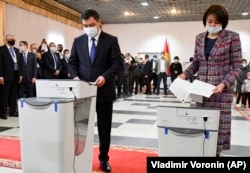The controversial new constitution that returns Kyrgyzstan to a presidential form of government has been approved in a nationwide referendum, but almost everything surrounding the document suggests it may live a short life in a country that has had three revolutions in 16 years.
Central Election Commission (CEC) Chairwoman Nurzhan Shayldabekova said on April 12 that 79.3 percent of those who cast ballots in the referendum -- some 1.03 million people -- voted in favor of the new constitution, with just 13.65 percent voting against it.
Kyrgyzstan has some 6.5 million citizens, so it is possible to question whether the approval of this new constitution represents the will of the people when less than 1-in-6 citizens voted for it.
Only 30 percent of Kyrgyzstan’s eligible voters needed to participate for the April 11 referendum to be declared legitimate. Preliminary results show some 37.1 percent of eligible voters cast their ballots in the poll, as local elections and the referendum were held simultaneously.
That is slightly less than the approximately 39 percent who turned out for the January 10 election in which voters chose a new president and decided to hold the constitutional referendum.
Some 1.35 million people cast ballots in January, with 81.44 percent -- about 1.1 million people -- voting in favor of holding the referendum.
But controversy surrounded the new constitution from the very beginning.
Shortly after being freed from jail by a mob during the unrest that followed the fraudulent October 4 parliamentary elections, Sadyr Japarov -- who was subsequently elected president in January -- suggested changing the semi-parliamentary form of government that Kyrgyzstan has had since 2010 to a presidential one under a new constitution.
The newly approved constitution is very similar to what Kyrgyzstan had under former Presidents Askar Akaev and Kurmanbek Bakiev, both of whom were chased from power partly due to amendments to the constitution that gave them more power.
Japarov and others argued that the 2010 constitution, which was also adopted in a referendum, created a parliament filled with deputies who bought their seats and mainly bickered, accomplishing very little.
The October 4 polls were eventually annulled after large demonstrations. With their mandates expiring and no replacement elections scheduled, the parliamentary deputies who were elected in 2015 voted to extend their mandates, which were to expire on October 28.
Many legal experts say that action puts into question every decision this parliament has made since its term was extended.
The same parliament then passed the draft of the new constitution on all three readings in December over the course of a few days, which violated the constitution that was still in effect.
Several changes were also made to the draft constitution after it had been approved by parliament, which many of its detractors note.
Furthermore, the decision in late November to form a Constitutional Chamber and the subsequent selection of its 89 members has also been called into question.
Many also wonder how much, if any, of the public's opinion played a role in drafting the new constitution, which was also supposed to be put up for public discussion before it was approved by parliament. But that was not done.
That is in great contrast to the 2010 constitution, which civil society and other public groups contributed to during the drafting stage.
WATCH: October's Upheaval In Kyrgyzstan Followed Two Revolutions This Century
Polls conducted in the days leading up to the April 11 referendum indicated most people did not know very much about the changes contained in the new constitution.
Fresh parliamentary elections that were originally scheduled to be held just days after the October 4 elections were later postponed.
It now seems new parliamentary elections will take place no sooner than this summer, which is strange since it was the popular resistance to the October 4 parliamentary elections that started Kyrgyzstan down its current path that led to the new constitution being approved.
Parliament loses many of its powers under the constitution approved on April 11, which also reduces the number of seats in the body from 120 to 90.
It is not difficult to see that there is ample ground for people to question the legitimacy of this new constitution, something Kyrgyz citizens could do if the become dissatisfied with the new president and his government.
Opponents of the new constitution will say that the constitution was pushed through by a leader who was in prison until October 4; drafted by a group that the public had no role in appointing; approved by a parliament whose mandate had expired; altered after that approval; and endorsed by less than 16 percent of the country’s population in a referendum.
In 2005, 2010, and 2020, such dissatisfaction led to the ousting of the country's leaders.










